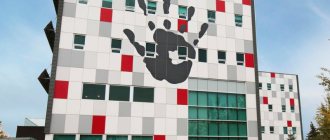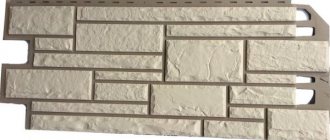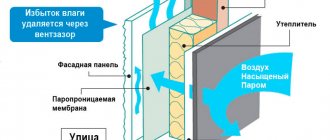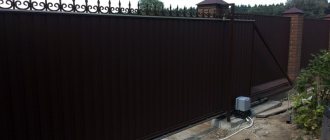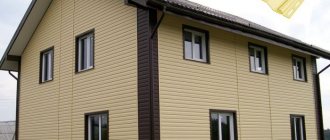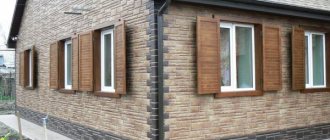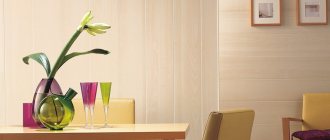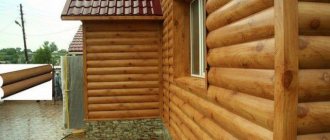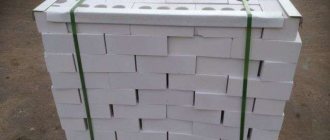Manufacturers of facade panels present a wide range of materials that meet increased requirements for their quality.
Cladding panels differ in color, method of fastening, texture, shape, and material of manufacture. Facade elements can imitate various natural materials: wood, natural stone, sandstone, as well as artificial stones, tiles, bricks.
Any imitations are presented in various color options. Natural imitations are made with such authenticity that it is quite difficult to distinguish them from natural species.
Features of wood panels
Facade slabs imitating wood are advantageous in that their main advantage over natural materials is moisture resistance.
Despite the fact that natural wood for outdoor use is treated with special moisture-protective and antiseptic agents, the material is short-lived due to its organic structure, and it can also attract insects and bugs.
Wood cladding imitates natural material so faithfully that only upon close examination is it possible to tell the difference. The cladding can be similar to an oak board, spruce, or pine log.
Different colors and textures of panels are characteristic of a certain type of wood. Basically, wood-look elements have a horizontal fastening, which more clearly corresponds to a laid board or rounded log. In addition, installation of the facing material is quite simple and does not require additional labor.
Advantages of vinyl basement siding
- Light weight. Facade facing panels made of PVC are very light - up to 3 kg. Therefore, they can be installed on fragile structures, old buildings and wooden houses.
- Durability. Wall panels last from 20 to 50 years. The thickness of building materials of this type can reach 3 mm.
- Wear resistance. Siding retains its characteristics under the influence of low and high temperatures. Mold does not grow on it. The material can withstand strong gusts of wind and light physical activity.
- Easy cleaning. Polymer facade siding does not require special care. It can be washed with water or soapy water.
- Price. The price of the products is favorable compared to natural materials. Wall panels are inexpensive - from 220 rubles per sheet.
- Quick installation. The dimensions of the basement siding are from 0.39 to 0.45 m2. It is installed on the cladding, which is given the desired shape. The profile has special locks with which the elements are tightly attached to each other.
Advantages and disadvantages of panels
In addition to moisture resistance, wood-look elements have positive distinctive characteristics that determine their advantage over natural materials:
- durability _ Some manufacturers guarantee preservation of performance properties for more than 30 years;
- strength . The impact and mechanical strength of the boards depends on the material, but even the most durable among analogues - PVC panels - are quite durable and can withstand external influences well;
- stability of the canopy covering from the external action of atmospheric phenomena;
- resistance of the material from ultraviolet rays . The color, its saturation and brightness of some types is maintained throughout the entire operational period;
- resistant to temperature changes and not subject to rotting and corrosion;
- hide the old walls of the building that require updating and repair;
- easy to install;
- the specifics of the installation ensure ventilation between the wall and the cladding, which ensures a comfortable microclimate in the room;
- resistance to the spread of fungus and mold;
- provide decorative design of the facade.
In addition, facade panels are much cheaper than natural wood, which is a significant positive criterion when choosing a material.
The disadvantages of façade panels include the ability of some types to fade , which significantly shortens the service life.
NOTE!
Panels require replacement of the entire element in case of mechanical damage or bending.
Therefore, when purchasing, you should purchase several spare sheets of cladding.
In addition, polyvinyl chloride panels are quite fragile in frost, and metal types become very hot in the sun, which increases the air temperature in the room.
Features of working with the material
When purchasing panels, you need to inspect them carefully. You should not purchase a product with broken geometry, uneven color, noticeable darkening (this may be one of the signs of rot) or falling knots. All this indicates low quality wood. At the first frost or any sudden temperature change, the slats may crack.
It is necessary to provide ventilation between the sheathing and the wall. If the moisture does not evaporate from here, this will lead to the wood absorbing moisture, which can lead to rotting of the material. As a result, beautiful panels for decorating the outside of the house will quickly become unusable.
It is better to sheathe a house in the warm season, when the weather is dry. It is not recommended to install slats in the rain, as this may damage them or change their geometry.
The weight of the slats must be taken into account. Some of them may have a very large mass, which may be excessive for the foundation.
Types of wood-look façade panels
Imitation wood is the most popular type. Therefore, the theme of “wood” is present in the collections of hanging structures made from all materials provided.
The main types of boards that imitate wood are classified according to their composition (the material from which they are made).
Metal
Wood-look metal elements are an affordable cladding option. Inexpensive durable sheets belong to the category of ventilated facade cladding structures.
The distinctive qualities of metal cladding are non-flammability, color fastness, strength and durability. The only disadvantage of this type is the ability to heat up in the sun.
Polyvinyl chloride
Their PVC panels are the most popular due to their quality characteristics. Their PVC wood-look line imitates natural wood well . The material is light, quite durable, moisture-resistant, and withstands natural influences well.
It is believed that PVC panels fade quite quickly, but this is most likely the characteristics of the first types of this material. Currently, manufacturers use high-tech coatings that help maintain color brightness for quite a long time.
Plastic
Hanging structures made of plastic are popular not only because of their durability and aesthetic appeal, but also the price of such materials is quite low. Excellent for finishing outbuildings and country houses.
Weather resistance and practicality of this type of wood-look panels are the main advantages of this type.
Fiber cement
The basis of such elements is cement with an admixture of fibrous parts and cellulose. The increased strength of this type, environmental friendliness and durability ensure that fiber cement coating is in demand in the market.
The only drawback of this design, which imitates wood cladding, is the weight. The foundation load must take into account the fairly heavy weight of this suspended cladding.
WPC facade board
This type of wood cladding is characterized by good sound insulation properties and low thermal conductivity.
The panels are made of pressed sawdust and covered with a high-tech polymer coating, which ensures the material's moisture resistance and resistance to external factors.
Sandwich panels
A fairly new type of cladding curtain panels that qualitatively imitate a wooden covering. The sandwich element is a multilayer structure that reliably protects the building from damage and external factors.
There is a layer of insulation in the panel, which provides excellent sound insulation and thermal insulation . The material is quite expensive, but at the same time durable and high quality.
Concrete
Concrete hanging structures are the strongest and most durable of the presented types. They are not affected by temperatures, are wear-resistant, and imitate a wooden coating quite well . They are not exposed to fire and do not bend. The only drawback of this type is the heaviness of the hanging system.
Panels made of any material that imitate wood quite accurately replicate the texture and texture of natural wood. The buyer’s choice should focus not only on the material of manufacture, but also on the manufacturer.
Care
In order for the exterior decoration of a wooden house to last for a long time, it is necessary to care for it correctly and in a timely manner. There are several options for wood processing:
- Oil paint;
- varnishing;
- azure coating.
Paint is one of the oldest ways to preserve wood from external influences. It creates a strong and reliable film on the surface. But at the same time, the appearance of the tree and its color are completely lost. The slats lose their individuality and resemble plastic. In addition, the surface must be repainted every 2-3 years. So the most economical, at first glance, option can eventually cost much more than similar ones.
The wooden surface must be treated
The azure coating allows you to preserve the texture and appearance of the wood longer. It needs to be renewed much less often: each layer can last up to 6 years. . With its help, you can achieve interesting artistic effects, since glaze gives the wood different shades (this depends on the species and the composition of the coating) and even colors. However, over time, the wood will still lose its original appearance, since a large number of layers still hides the pattern and texture of the wood.
Varnish is another longtime friend of wood. It very reliably protects the coating from various aggressive influences, which is why it was and is so often used on ships, yachts, etc. It perfectly preserves the appearance of wood, gives it a noble appearance, slightly changes its shade, which can be used to create an interesting and beautiful facade. Even after many layers, the grain of the wood is clearly visible and its individuality is not lost. However, here you need to be very picky about the quality of the coating. Bad varnish peels off quickly; in this case, the surface will have to be treated frequently.
A technique such as using more resistant species will help extend the service life. For example, now there are both tropical varieties and thermally modified material on sale. In this case, the panels are less demanding to maintain; they themselves will last longer without requiring frequent processing.
Main manufacturing companies
Manufacturers of hanging panels for exterior home decoration try to ensure that their products meet all standards for quality, environmental friendliness, and durability. It is based on quality indicators that companies gain popularity in the market.
The main manufacturers of panels are:
- Docke is a Russian company with German production technology and equipment;
- Neva-Steel is a St. Petersburg company. It is expanding quite quickly and has good ratings among competitors;
- Vox is a Belarusian manufacturer. Produces high-quality panels;
- Holzplast is a Russian-German company that has good quality materials and produces a line of wood-look materials;
- Alfa-Profile is a Russian manufacturer. Produces competitive materials.
Installation features
Installing the panels is not difficult; almost all types are laid the same way. The exception is the fiber cement option: it is installed without special fittings, creating the feeling that the house is lined with natural boards. The panels can be placed in a vertical or horizontal position, uncut corners are hidden by edging or overlay elements.
Choose the type of lathing that is easier for you to work with
General scheme of work with polymer and metal products:
- The foundation is being prepared.
- Waterproofing and, if necessary, insulation must be installed.
- The starting bar, external and internal complex corner are mounted. In their absence, overlays are used.
A frame is created from a metal profile or wooden beam.
Scheme of covering a house with siding with insulation
Sheathing the facade is not difficult, the main thing is to install all the elements correctly and accurately. If there is a need to create a single plane, then the fragments are overlapped.
Wood siding
It is considered the most expensive material. Made from pre-treated wood. It has a large selection of colors; you can find colors that imitate different tree species. The sheets are fixed to the surface using hardware that is passed through through holes. The panels are connected using the tongue-and-groove principle.
The advantages include:
The disadvantages of such siding are:
- flammability,
- fragility,
- not resistant to water,
- the need for annual maintenance (impregnation against fungus and moisture, painting of the entire structure).
Types of siding for exterior cladding of houses
The very first siding that the construction industry began to use was a wooden board made of pine or spruce.
Wooden siding, wooden facade board or lining, in carpentry parlance, has lost its popularity due to the need to be coated with paint or varnish approximately every 3 years. Knot-free lining is incredibly expensive. Lining of category B, C is more accessible, but contains knots that not everyone likes. Thermal expansion of the material is also a problem. A poorly dried board is damaged; it can crack when moisture escapes and even become black in color, as wood “blooms” from moisture.

